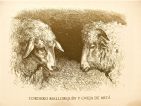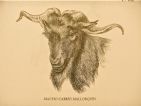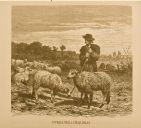
Lamb, sheep and goats
"On occasion of Easter festivities, a large number of lambs, sheep and suckling lambs are sacrificed, a custom among 4/5 of Mallorcan families in the countryside. Even in Palma, a lot of people kill a lamb on these dates. In other towns, by contrast, for example in Felanitx, the poorest people occasionally raise a goat for the holidays, sacrificing it when the day comes. One part of the lamb is roasted, while the other part is taken advantage of to make small pies (panades).
We have to distinguish between lambs, sheep and suckling lambs whose meat is sold by butchers or, better said, in the town’s meat market and those animals sacrificed for private use. In the majority of large towns like Palma, Inca, Felanitx, Manacor and Sóller, the number of animals destined for public consumption is much higher than the number of those sacrificed for personal use.
In the towns of Calvià and Andratx, especially in the populated mountainous areas also in other places in the island, numerous poor families fatten a lamb and take it to market on Wednesday or Thursday of Easter week. Once they’ve made their sale, they hurry to buy another young lamb for the same purpose.
The amount of goat meat eaten is relatively low, and there are towns where it is not at all liked. Only in Inca, Sa Pobla, Artà, Capdepera, Felanitx, Manacor, Pollença and Palma does the number of sacrificed goats have some importance if we include kids. In Palma, by contrast, the consumption of this meat has been diminishing for some years.
There are four breeds of very different Mallorcan sheep.
The most common and found in every town is the autochthonous Mallorcan breed, with somewhat coarse wool, referred to on the peninsula as the oveja de lana churra or oveja de lana burda. They are very large animals, and the males tend to lack horns. They are characterized by their long legs, hanging ears and tails which nearly touch the ground. Their wool is white, with long, coarse locks. Their snouts and front legs are black with dark brown spots. Some males do grow horns even if their parents are hornless.
The Merino wool lamb, by contrast, is not very common on the island, though it can be found on the La Marina estate in Llucmajor and around the town of Inca.
The ovelles de muntanya (“mountain sheep”) have to be considered a sub-species of the first above, typical of the valleys in the mountainous areas between Sóller and Formentor. They are much smaller and distinguished by a much more fragile frame, a large tail, short horns and relatively fine wool. It seems that this breed is the result of poor pastures and little food found during some months of the year in those areas. If they take large sheep from the plains to these mountainous areas, they soon die as a result of the meager forage or they degenerate in such a way that, after a few generations, they can barely be distinguished from the mountainous variety.
 The fourth breed is known by the name of ovelles d’Artà. We could say that they are a dwarf variety, with a frame similar to that of a recently born lamb but without the latter’s disproportionately long legs. As we can see in the woodengraving, the shape and appearance of their heads is, by contrast, very different, given that the Mallorcan lamb has a very pronounced snout while that belonging to Artà sheep is completely straight.
The fourth breed is known by the name of ovelles d’Artà. We could say that they are a dwarf variety, with a frame similar to that of a recently born lamb but without the latter’s disproportionately long legs. As we can see in the woodengraving, the shape and appearance of their heads is, by contrast, very different, given that the Mallorcan lamb has a very pronounced snout while that belonging to Artà sheep is completely straight.
Goats are much less abundant. There are towns where there are absolutely none. In addition, their numbers have dropped day to day, to the point that in some regions they have disappeared altogether. Smart owners do without these animals given the severe damage they cause plantations, substituting them for sheep. This tendency has increased with the expansion of almond, fig and other tree plantations. It only seems appropriate to multiply the number of goats in those places which are wealthy in terms of mastics and other shrubs which, in addition to being sufficiently far from populations so that their wood lacks commercial value. Regardless of the latter, the number of these animals is still relatively important in the municipalities of Artà, Manacor, Felanitx, Pollença, Escorca, Llucmajor, Palma, Calvià, Andraitx and some others."
Archduke Ludwig Salvator of Austria. Las Baleares por la palabra y el grabado. Majorca: General Part. Ed. Sa Nostra, Caja de Baleares. Palma de Mallorca. 1982.
























